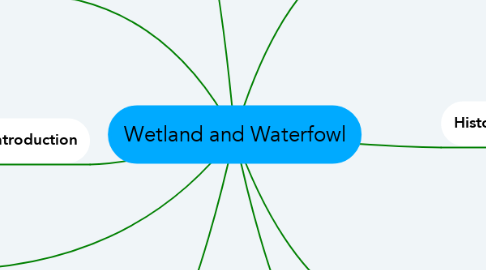Wetland and Waterfowl
by Owen Natzel


1. Introduction
1.1. Wetlands are mostly important to waterfowl species.They also help humans by reducing floods, filtering pollutants out of the water.
2. Major Wetlands Types
2.1. Marshes
2.1.1. Marshes have standing water from less than an inch to several feet deep.
2.2. Swamps
2.2.1. Swamps can best be described as flooded woodlands or shrub lands.
2.3. Bogs
2.3.1. Bogs occur where accumulations of decaying vegetation form mats that eventually cover then fill in pond or lakes.
3. What Are the Threats to Wetlands?
3.1. The wetland are being flooded by lakes or rivers and becoming part of the water area.Also being built on by people.
4. Annual Cycles and Seasonal Needs
4.1. Waterfowl experience an annual cycle that includes several stages, generally dependent on the season.Waterfowl depend on a mix of wetlands and associated uplands throughout the year as their cover and food.
5. Management Consderations
5.1. Landowners can adopt many practices to increase the number and kinds of waterfowl on their own lands.Like temporary shallow pools and seasonally flooded woodlands or fields are just as important as permanent wetlands such as swamps,marshes,ponds, and streams.
6. History
6.1. Michigan's wetland are very important to history.12,000 years ago there ice age came to a end.Slowly lake and rivers formed.The wetlands are getting destroyed now.
7. Why are Wetlands Important?
7.1. Help recharge groundwater supplies when connected to underground aquifers.Wetland produce more wildlife and plants than any other habitat.
8. Wetland Regulations
8.1. With its vast water resources, Michigan is a key state for protecting and managing North American waterfowl population.
9. Life Cycle of Tree Common Waterfowl
9.1. Wood duck
9.1.1. Arrive in Michigan from southern wintering areas typically in March.
9.2. Blue-winged teal
9.2.1. Prefer seasonally or temporarily flooded, shallow wetlands.
9.3. Mallards
9.3.1. Is the most extensive of any duck species in North America

